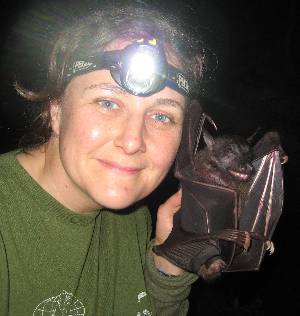Tigga Kingston
Email: tigga.kingston@ttu.edu
Phone: 1(806)834-2594
- PhD, Ecology, Behavior and Evolution, Boston University (2001)
- MA, Ecology, Behavior and Evolution, Boston University (1999)
- BSc(Hons), Zoology, Royal Holloway University of London (1993)
Web Links:

Research Interests
My research centers on the study of chiropteran diversity and the processes that create it (speciation), maintain it in intact ecosystems (community ecology), and preserve it in the face of human disturbance (conservation biology). My work focuses primarily on the insectivorous bats of South East Asia; a species-rich group that occurs as highly diverse assemblages in the threatened rainforests of the region. Indeed, by the end of this century, we estimate that more than a fifth of South East Asia's bats will be globally extinct.
Selected Publications
- Benjamin Lee, Matthew Struebig, Stephen Rossiter & Tigga Kingston (2015). Mounting concern over trade in bat souvenirs from Southeast Asia. Oryx 49: 204-204.
- Juliana Senawi*, Daniela Schmieder, Bjorn Siemers and Tigga Kingston (2015). Beyond size – morphological predictors of bite force in a diverse insectivorous bat assemblage from Malaysia. Functional Ecology -- DOI: 10.1111/1365-2435.12447
- Joe Chun-Chia Huang*, Elly Lestari Rustiati, Meyner Nusalawo, Ibnu Maryanto, Maharadatunkamsi, Sigit Wiantoro & Tigga Kingston (2014). A recent survey reveals Bukit Barisan Selatan Landscape
- Kingston, T. (2013). Response of bat diversity to forest disturbance in Southeast Asia – insights from long-term research in Malaysia. Pp 169-185. In: Bat Evolution, Ecology and Conservation (eds. RA Adams, SC Pedersen). Springer Science Press.
- Schmieder, D., Kingston, T., Rosli, H., & Siemers, B. 2012. Sensory constraints on prey detection performance in an ensemble of vespertilionid understorey rainforest bats (Kerivoulinae, Murininae). Functional Ecology 41(2):1-10. doi: 10.1111/j.1365-2435.2012.02024.x
- Rossiter, S. J., Zubaid, A., Adura, A., Struebig, M. J., Kunz, T. H., Gopal, S., Eric J. Petit & T. Kingston (2012). Social organisation and gene flow: insights from co-distributed bat populations. Molecular Ecology 21: 647–661 DOI: 10.1111/j.1365-294X.2011.05391.x
- Murray, S., Campbell, P., Kingston, T., Zubaid, A., Francis, C. M., and T. H. Kunz (2012). Molecular phylogeny of hipposiderid bats from Southeast Asia and evidence of cryptic diversity. Molecular Phylogenetics and Evolution 62: 597-611.
- Struebig, M. J., T. Kingston, E. J. Petit, A. Zubaid, A. Mohd.-Adnan & S. J. Rossiter. (2011). Parallel declines in species and genetic diversity in tropical forest fragments. Ecology Letters 14: 582-590.
- Kingston, T. (2010). Research priorities for bat conservation in Southeast Asia: a consensus approach. Biodiversity and Conservation, 19:471-484
- Schmieder, D., Kingston, T., Rosli, H. & Siemers, B. (2010). Breaking the trade-off: rainforest bats maximise bandwidth and repetition rate of echolocation calls as they approach prey. Biology Letters, 6: 604-609.
- Kingston, T. ( 2009). Analysis of species diversity of bat assemblages. Pp 195-215. In: Behavioral and ecological methods for the study of bats, 2nd Edition (eds., T. H. Kunz & S. Parsons), Smithsonian Institution Press, Washington.
- Struebig, M. J., Kingston, T., Zubaid, A. et al. (2008). Conservation value of forest fragments to Palaeotropical bats. Biological Conservation, 8:2112-2126.
- Francis, C. M., Kingston, T. & Zubaid, A. (2007). A new species of Kerivoula (Chiroptera: Vespertilionidae) from Peninsular Malaysia. Acta Chiropterologica, 9:751-756.
- Lane, D. W. J., Kingston, T. & Lee, B. P. Y-H. (2006). Dramatic decline in bat species richness in Singapore, with implications for Southeast Asia. Biological Conservation, 131: 584-593.
- Thabah, A., Rossiter, S. J., Kingston, T., Zhang, S., Khin Mya Mya, Zubaid, A., Parsons, S. & Jones, G. (2006). Genetic divergence and call frequency in cryptic species of Hipposideros larvatus (Chiroptera: Hipposideridae) from northeast India and comparisons with other Indo-Malayan populations. Biological Journal of the Linnean Society, 88: 119-130.
- Kingston, T. & Rossiter, S. J. (2004). Harmonic-hopping in Wallacea's bats. Nature, 429; 654–657.
- Kingston, T., Francis, C. M., Zubaid, A. & Kunz, T. H. (2003). Species richness in an insectivorous bat assemblage from Malaysia. Journal of Tropical Ecology, 19; 67-79.
- Kingston, T., Lara, M. C., Jones, G., Zubaid, A., Kunz, T. H. & Schneider, C. J. (2001). Acoustic divergence in two cryptic Hipposideros species: a role for social selection? Proceedings of the Royal Society, London, B., 268; 1381-1386.
- Kingston, T., Jones, G., Zubaid, A. & Kunz, T. H. (2000). Resource partitioning in rhinolophoid bats revisited. Oecologia, 124; 332-342.
- Kingston, T., Jones, G., Zubaid, A. & Kunz, T. H. (1999). Echolocation signal design in Kerivoulinae and Murininae (Chiroptera: Vespertilionidae) from Malaysia. Journal of Zoology, 249; 359-374.
Department of Biological Sciences
-
Address
Department of Biological Sciences, Texas Tech University, Box 43131 Lubbock, TX 79409 -
Phone
806.742.2715 -
Email
biology@ttu.edu
